Pohela Boishakh
| Pohelaa Boishakh | |
|---|---|
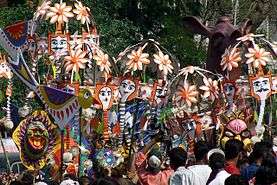 Pohela Boishakh celebration in Dhaka, Bangladesh | |
| Official name | পহেলা বৈশাখ |
| Observed by | Bengali people |
| Celebrations | Haal Khata, Boishakhi Mela |
| Observances | India and Bangladesh (14 April) |
| Frequency | annual |
Pohela/Poila Boishakh (Bengali: পয়লা বৈশাখ, or Bengali New Year Bengali: বাংলা নববর্ষ, Bangla Nôbobôrsho) is the first day of the Bengali calendar, celebrated on 14 April or 15 April in Bangladesh and in the Indian states of West Bengal and Tripura by the Bengali people and also by minor Bengali communities in other Indian states, including Assam, Jharkhand and Orrisa. It coincides with the New Year's days of numerous Southern Asian calendars like Tamil new year Puthandu. The traditional greeting for Bengali New Year is শুভ নববর্ষ "Shubhô Nôbobôrsho" which is literally "Happy New Year".
Names
In Bengali, Poila (Bengali: পয়লা) stands for ‘first’ and Boishakh (Bengali: বৈশাখ) is the first month of the Bengali calendar. Bengali New Year was referred to in Bengali as "New Year" (Bengali: নববর্ষ Noboborsho) or "First of Boishakh" (Bengali: পহেলা বৈশাখ Pôhela Boishakh).
History and calendar
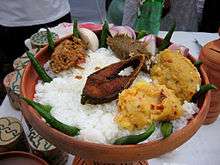
The Bengali calendar is tied to the Indian solar calendar, based on the Surya Siddhanta. The first day of the Bengali year coincides with the mid-April new year in Mithila, Assam, Burma, Cambodia, Kerala, Manipur, Nepal, Odisha, Sri Lanka, Tamil Nadu and Thailand. All Bengali Hindus follow the traditional date of 15 April as Poila Boishakh. The length of a year is counted as 365 days, as in the Gregorian calendar. However, the actual time taken by the earth in its revolution around the sun is 365 days 5 hours 48 minutes and 47 seconds. To make up this discrepancy, the Gregorian calendar adds an extra day, to make a leap year, to the month of February every fourth year (except in years divisible by 100 but not by 400). To counter this discrepancy, and to make the Bengali calendar more precise, the following recommendations of the Bangla Academy are followed:
- The first five months of the year from Bôishakh to Bhadrô will consist of 31 days each.
- The remaining seven months of the year from Ashwin to Chôitrô will consist of 30 days each.
- In every leap year of the Gregorian calendar, an additional day will be added in the month of Falgun (which is 14 days after 29 February).
The first day of the New Year of the Indian solar calendar and all derived calendars including Bengali calendar is the first day of the new year, and historically the day has been seen across the subcontinent as the day for a new opening and celebrated accordingly. In Bengal landlords used to allocate sweets among their tenants, and business people commenced a “Halkhata” (new financial records book) and locked their old ones. Vendors used to provoke their consumers to allocate sweets and renew their business relationship with them. There were fairs and festivities all over.
Traditions
The Bengali New Year begins at dawn, and the day is marked with singing, processions, and fairs. Traditionally, businesses start this day with a new ledger, clearing out the old.
People of Bangladesh enjoy a national holiday on Poila Boishakh. All over the country people can enjoy fairs and festivals. Singers perform traditional songs welcoming the new year. People enjoy classical jatra plays.
Like other festivals of the region, the day is marked by visiting relatives, friends and neighbors. People prepare special dishes for their guests.
The festivities from the deep heartland of Bengal have now evolved to become vast events in the cities, especially the capital Dhaka.
In Dhaka and other large cities, the festivals begin with people gathering under a big tree. People also find any bank of a lake or river to witness the sunrise. Artists present songs to welcome the new year, particularly with Rabindranath Tagore's well-known song "Esho, he Boishakh". It is tradition to enjoy a meal of 'pantha bhaat and ilish maach'( fermented rice and hilsa fish) on this day. Nowadays People Use To send Pohela Boishakh Special Sms To there nearest Friends And Family Member.
People from all spheres of life wear classic Bengali dress. Women wear saris with their hair bedecked in flowers. Likewise, men prefer to wear panjabis. A huge part of the festivities in the capital is a vivid procession organized by the students and teachers of Faculty of Fine Arts, University of Dhaka. According to the history, the rudimentary step of MONGOL SUVAJATRA was started in Jessore by CHARUPITH, a community organization, in 1986. Later in 1989 Faculty of FIne Arts, University of Dhaka arranged this MONGOL SUVAJATRA with different motives yearly. Now, the MONGAL SUAJATRA is celebrated by different organization in all over the country.[2] [3]
Of the major holidays celebrated in Bangladesh and West Bengal, only Pôila Boishakh comes without any preexisting expectations. Unlike Eid ul-Fitr and Durga Pujo, where dressing up in lavish clothes has become a norm, or Christmas where exchanging gifts has become an essential part, Pôila Boishakh is about celebrating the simpler, rural heartland roots of the Bengal.
In Dhaka

Poila Boishakh is celebrated with grandeur and colours in Dhaka and other parts of Bangladesh. The celebrations are started at the break of dawn with a rendition of Rabindranath Tagore's song "Esho he Baishakh" by Chhayanat under the banyan tree at Ramna (the Ramna Batamul). An integral part of the festivities is the Mangal Shobhajatra, a traditional colourful procession organised by the students of the Faculty of Fine Arts, University of Dhaka (Charukala). The procession has a different theme relevant to the country's culture and politics every year. Different cultural organizations and bands also perform on this occasion and fairs celebrating Bengali culture are organized throughout the country. Other traditional events held to celebrate Poila Boishakh include bull racing in Munshiganj, wrestling in Chittagong, boat racing, cockfights, pigeon racing.[4]
In Chittagong Hill Tracts
In the Chittagong Hill Tracts alongside Pahela Baishakh, Boisuk of Tripuri people, Sangrai of Marma people and Biju of Chakma people have come together as Boi-Sa-Bi, a day of a wide variety of festivities that is observed on the last day of Chaitra, i.e., 13 April. The day is a public holiday in the Chittagong Hill Tracts.
In Kolkata
In Kolkata, Poila Boishakh (and the entire month of Boishakh) is considered to be an auspicious time for marriages. These days people wear new clothes and go about socialising. Choitro, the last month of the previous year, is the month of hectic activities and frantic purchases. Garment traders organise a Choitro sale and sell the garments with heavy discounts.
Poila Boishakh is the day for cultural programmes. Prayers are offered for the well-being and prosperity of the family. Young women clad in white saris with red borders and men clad in dhuti and kurta take part in the Probhat Pheri processions early in the morning to welcome the first day of the year. This day being auspicious, new businesses and new ventures are started. The Mahurat is performed, marking the beginning of new ventures.
Poila Boishakh is the beginning of all business activities in Bengal. The Bengali Hindu traders purchase new accounting book. The accounting in the halkhata begins only after offering puja. Mantras are chanted and স্বস্তিক shostik (Bengali swastika) are drawn on the accounting book by the priests. Most of the shops, business centres and market-places are decorated with flowers, garlands and auspicious 'aam' leaves.
Long queues of devotees are seen in front of the Kalighat Temple and Dakshineswar Kali Temple from late night. Devotees offer puja to receive the blessings of the almighty.
On Poila Boishakh fairs are held in West Bengal. The most famous of these is Bangla Sangit Mela, held at Nandan-Rabindra Sadan ground. It is conducted by the Government of West Bengal.
Celebration in other countries
United States
In the United States, Bengali New Year is celebrated by Bengali heritage people and businesses by cultural programs, food festivals, street fairs/patha mela, arts, music, food, clothes, etc. Pohela Boishak observance occurs in USA mostly during the spring recess when most of the schools and colleges have days off.
Australia
In Australia, the Bengali new year is celebrated in cities such as Sydney, Melbourne and Canberra through Boishakhi Melas (fairs) where people gather to celebrate the culture Bengalis through dances, fashion shows, stalls of art, music, clothing, food, etc.
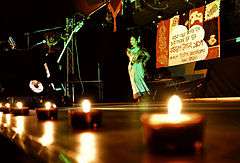
The largest celebration for the Bengali new year in Australia is the Sydney Boishakhi Mela which was traditionally held at the Burwood Girls High School; from 2006 it has been held at the Sydney Olympic Park. It attracts large crowds and is a very anticipated event on the Australian Bengali community calendar.
Canada
Bangladesh Heritage and Ethnic Society of Alberta in Canada celebrates its Heritage Festival (Bengali New Year) in a colorful manner along with other organizations. Bengali people in Calgary celebrate the day with traditional food, dress, and with Bengali culture.[5][6]
Sweden
The festival is celebrated in Sweden with great enthusiasm.
United Kingdom
The United Kingdom is known as the second home for Bengalis because the number of Bengali expatriates in the United Kingdom is higher than that in any other countries in the world which is why they celebrate every festival with great enthusiasm including Pohela Boishakh. The Bengali community in the United Kingdom celebrate the Bengali new year with madar — a street festival in London. It is the largest Asian festival in Europe and the largest Bengali festival outside of Bangladesh and Indian state of West Bengal.
UAE
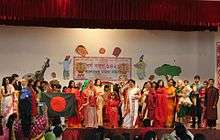
The Bengali community in UAE celebrate the Bengali new year in Abudhabi and Dubai every year.
In Abudhabi a food festival is arranged by the Bangladesh Embassy where Bangladeshi foods are presented in a festive manner. A cultural program is arranged by the Women Association, Abudhabi which is held in Bangladesh School, Abudhabi. Singing boishaki songs, traditional dancing and a fashion show representing Bangladeshi rural people's lives are presented.
In Dubai similar programs are arranged by consulate general of Bangladesh. Traditional Panta bhat and illish (Hilsha) are served along with traditional pitha. Children comes with festoon, mask, placard and national flag and enjoy many games. Women wear traditional colorful sharees and sometimes make alpona. The program gives a vibe to Bangladeshi culture and people enjoy it.
See also
Gallery
-
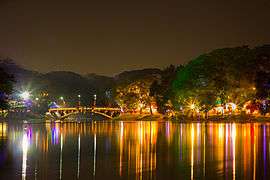
Night view of Dhanmondi lake in Pohela Boishakh
References
- ↑ Mangal Shobhajatra on Pahela Baishakh
- ↑ http://archive.ittefaq.com.bd/index.php?ref=MjBfMDRfMTRfMTRfM181NF8xXzEyMzIyNg%3D%3D
- ↑ http://www.prothom-alo.com/opinion/article/829435/%E0%A6%AE%E0%A6%99%E0%A7%8D%E0%A6%97%E0%A6%B2-%E0%A6%B6%E0%A7%8B%E0%A6%AD%E0%A6%BE%E0%A6%AF%E0%A6%BE%E0%A6%A4%E0%A7%8D%E0%A6%B0%E0%A6%BE%E0%A6%B0-%E0%A6%B8%E0%A7%82%E0%A6%9A%E0%A6%A8%E0%A6%BE
- ↑ "Nobo Borsho and Pahela Baishakh: The Past and the Present". The Daily Star. 14 April 2013.
- ↑ "Naba Barsha in Bengal". Retrieved 5 May 2016.
- ↑ http://bhesa.ca/index.php/events/events-bengali-event-heritage
External links
- Mohanta, Sambaru Chandra (2012). "Pahela Baishakh". In Islam, Sirajul; Jamal, Ahmed A. Banglapedia: National Encyclopedia of Bangladesh (Second ed.). Asiatic Society of Bangladesh.
